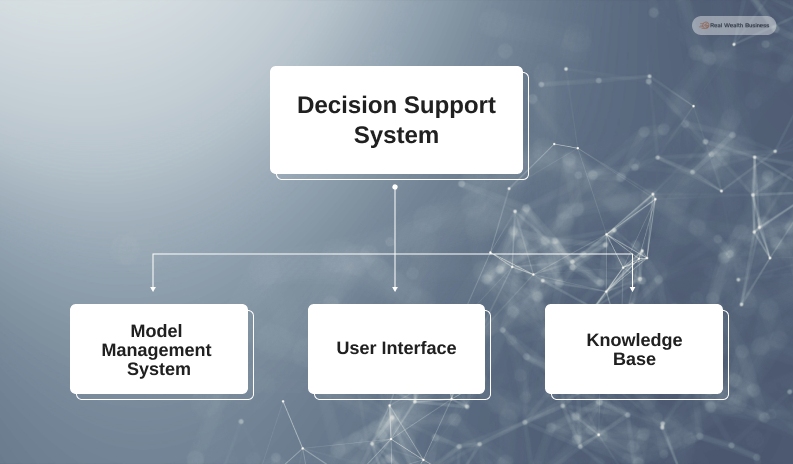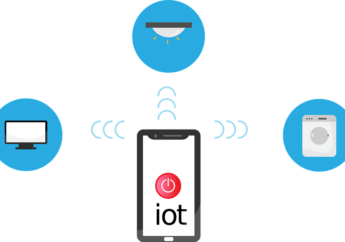AI revolutionizing Decision Support Systems for business – A Complete Guide
by Shahnawaz Alam Business Intelligence 13 February 2024

As we ushered in a new era with ChatGPT and similar AI tools, some repetitive tasks no longer need human labor. However, most decision-making tasks still require human input and intervention. However, with decision support systems in the mix, even decision-making gets automated.
An AI-powered Decision support system helps businesses automate tons of complicated research and analysis. They can easily derive insights and information from a DSS. But how does it change the business landscape? Keep reading for valuable information.
What is Decision Support System?

The intelligent decision support system is an AI-powered tool that helps businesses and organizations make better decisions through valuable data, analytics, and recommendations. It’s like hiring an artificial brain that does a lot of heavy reasoning and thinking for day-to-day decision-making.
It has different major parts or elements that help a business automate its decision-making process. The entire DSS system comprises different sources, a model, and a useful user interface.
How Does the Decision Support System Work?

Well, firstly, it is an AI-powered system. AI-powered Decision support systems, or DSS, automate the decision-making process by accessing different data sources and collecting data. It then uses its analytical capabilities to process the data and uses the data modeling capabilities to communicate the suggestions.
Yes, businesses, the government sector, and the healthcare sector can churn out a lot of their intricate data and get the IDSS to suggest valuable recommendations. Basically, that’s how a lot of the decision-making will be streamlined for businesses and other large organizations.
Decision Support System: The Elements

There are three different component groups of a decision support system. Usually, they are comprised of a knowledge base, user interface, and model.
Knowledge Base
The foundation of DSS is the knowledge base. It consists of different information and the knowledge a DSS needs to make useful decisions. In today’s time, a DSS has evolved to where businesses can use both structured and unstructured data to make valuable information.
The knowledge base also stores other types of data, such as model analysis and feedback from users. This data will be helpful for improvement in the future. So, the knowledge base also stores these data.
Model
The knowledge base is the source of data, and the model is responsible for using this database. The model uses and analyzes the data. It can be either a simple rule-based system or a complex algorithm backed up by machine learning.
Well, the model does more than that. In addition to data analytics, the model identifies trends, patterns, and insights and makes recommendations. Businesses use modern data architecture nowadays because of the vast amount of data they must process.
User Interface
The decision support system’s user interface is its visual part. It allows users of a DSS to communicate with the DSS and use the model and the knowledge base. The users can go through the User Interface to provide simulations, data inputs, and similar recommendations.
The user interface is also a key part of the DSS. Without a user-friendly DSS, the output and the process get delayed. Developers need to make DSS UI and UX user-friendly and easy to use.
Usually, they are graphical and are almost like mobile applications and web applications. But not every user uses a huge screen. In recent times, a huge part of good UX and UI makes use of voice-based chatbots. Things are moving into an AR and VR-based interface.
Whether based on AR/VR or through an interface, UI and UX are very important parts of the DSS. Modern DSS developers modify and customize the tools based on users’ needs.
Different Types of Decision Support Systems
There are different types of decision support systems. Here is the classification –
Model-Based DSS
The model based DSS is based on simple and quantitative models. For this type of DSS, a large database is not crucial. Some decision-makers provide some parameters for making decisions and limited information and work using the model. These are complex systems that help users choose between options.
Data-Driven
A data driven DSS is targeted at service providers, suppliers, and managers. This type of decision support system makes use of a data warehouse and asks it different questions to derive purpose-driven insights.
Data-driven DSS is the basis on which BI or business intelligence is built. Businesses are collecting data on a massive scale and building data warehouses. The Data-driven DSS results from the concept of a subject-oriented, time-variant, and non-volatile collection of data. This type of DSS usually prioritizes the collection of data, accessing and analyzing it for the sake of decision-making.
Group Communication Driven DSS
Communication-based DSSs are targeted at internal teams, coworkers, and employees. These DSS tools help derive meaningful insights from a meeting. It is based on communication technologies. This type of DSS makes use of different technologies, such as video conferencing, computer-based bulletin boards, and groupware.
Document Driven
A document driven DSS makes use of different documents. It uses different data such as scanned documents, images, hypertext documents, and videos. For a DSS like this, the search engine works as the primary help for decision-making.
Knowledge-Driven Decision Support System
Another type of decision support system is the knowledge-based decision support system. This model is based on a computerized model. The model stores information and can retrieve knowledge from the database as required.
In this case, knowledge is codified as probabilities, relationships, and rules. The developers use data mining and AI technologies to keep the knowledge codified and used as and when required.
In simple words, a knowledge-driven decision support system helps make better product choice decisions and provides management-related advice.
Decision Support System And The Industries It Will Help

When we look at it from an employment perspective, it seems like a lot of jobs will be lost because of AI-driven decision support systems. But AI will also create many jobs.
Finance & Investment: IDSS can help with stock and investment decisions. It will help both on a personal and corporate level. Individuals and businesses can use it to automate budgeting, planning, and investment decisions.
Healthcare: Doctors and healthcare professionals must handle a chunk of patient data, including diagnoses, patient reports, etc. IDSS will take the burden of handling data manually and help doctors with diagnosis, patient care, choosing treatment methods, etc.
Retail: retail businesses have thousands of product sales every day. Using this data to make proper marketing and sales decisions is difficult if we do it manually. But IDSS, or a decision support system powered by AI, will help retail businesses with inventory management, campaigns, and pricing.
Transportation: businesses in the logistics and transportation sector struggle with scheduling and maintaining routes. Thanks to IDSS, transportation, and trucking have become a lot easier.
Decision Support System Before AI

Let’s be clear about one thing first: a decision support system is not a computer-based tool or software. It is a support system comprised of human beings and led by human expertise – at least what it used to be before AI.
The practice of having a decision support system has been there for a long time. But, only recently, after ChatGPT and other AI tools proliferated, Intelligent Decision Support Systems are coming out as well.
Earlier businesses used to have human intuition, skills, heuristics, and expertise for making decisions. But, nowadays, a DSS can help create a flow chart or a checklist of some sort to help guide decision-making. IDSS makes the process easier by helping to set different parameters by adding multiple layers of perspective for an emerging issue.
Emergency responders, in a moment of crisis like earthquake, flood, or hurricane, can use these checklists or guidelines to identify potential threats or hazards. What’s more, it can help prioritize actions and make decisions regarding evacuation, rescue, and other recovery efforts.
Intelligent Decision Support System
Now that we have entered a digital era, everything is sort of digitized –including intelligent decision support systems.
Now, data is everywhere, and they are easily accessible. Businesses already generate enough data through transactions and marketing communications. They can always collect that data (maintaining the legal aspects, of course).
The trickiest part, on the other hand, is to process the data and make meaningful decisions using it. It is more than a challenge to draw meaningful insights from this. That’s where AI-powered decision support systems come in. Companies can now automate data processing and analysis using AI-driven Decision support systems.
The positive effect of this is that businesses will make better and more data-driven decisions. Also, data processing automation makes the decision-making process faster.
Benefits of Using a Decision Support System in Business

So, what happens when a business uses AI in a decision support system? Here are some of the key advantages of using a decision support system in business —
Easy and Fast Data Processing
IDSS needs an ample amount of valuable and reasonable data for making better decisions. The human brain takes more time to process a huge amount of data. IDSS makes it easy for businesses when it comes to processing data. AI can easily process huge chunks of data at a fast pace. Also, AI can easily find correlations and patterns amid massive sets of data.
Processing Unstructured Data
Businesses and different other large organizations have different types of data in different formats and layers. AI systems can use NLP to process different forms of data and derive structured and valuable insights.
Businesses usually have so much data from social media posts, surveys, reviews, and more. AI systems use NLP to process different types of data and extract valuable insights from it.
Data Filtering Process
When using data to make useful decisions, businesses must focus on information that is valuable to them. That is why data filtration is necessary. AI can help a business filter out irrelevant data that does not add value to decision-making.
Data Recommendation
AI-driven DSS helps generate recommendations based on the data collected and processed. Businesses, investors, and large organizations can use these recommendations to make useful decisions.
Avoid Biases
Human bias can often motivate or affect the decision-making process. AI can help businesses and investors with decision-making. Humans and data analysts can have emotional biases that might affect decision-making. That’s where AI only follows data to make decisions that are not distorted by personal biases.
Disadvantages of Using a Decision Support System
Of course, there are some advantages to using a decision support system. But here are some disadvantages of the DSS —
Money Intensive
A decision support system requires lots of money invested in it. Aside from being extremely helpful, a decision support system is also costly. So, a small organization trying to automate its decision-making process cannot afford the cost needed to set up a DSS. A simple explanation would be that a smart DSS is not easily accessible to smaller organizations.
Being Solely Dependent on a DSS
A company can be dependent on a DSS for all decisions made inside the organization. A daily decision-making process using DSS can improve efficiency and speed. However, managers relying solely on an IDSS can lose the human input needed to run a business. The lack of subjective effort in decision-making can have negative effects on a business.
Information Overload
A DSS can cause information overload. The knowledge base usually remains loaded with different types of information from different sources. So, when the model analyzes the data to provide any recommendation, the user is left with multiple choices. This creates confusion, making the users run the entire process manually all over again.
Employee Unrest
When companies or any type of organization start relying too much on technologies and data, they can create unrest and uneasiness among lower-end employees. Employees with inadequate explanations regarding these tools might be afraid of losing their jobs. Technology has been frightening for many people for a long time. This is just another one.
Final Words
Technology should always be an ally and not an enemy. Of course, some work needs to be automated, but the decision-making process will always require human input because any business involves humans, after all. Decision support systems should never replace humans. However, businesses and different organizations can use it to simplify complex calculations and hours of reasoning process.
Hopefully, this article was helpful. Please let us know your thoughts on this. Thank you for reading.
For More Business Related Articles Click Below!!







































































































